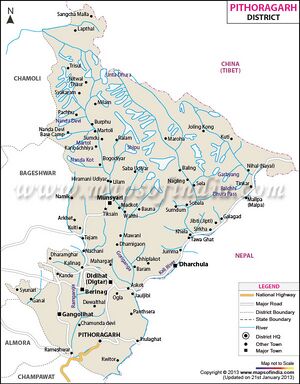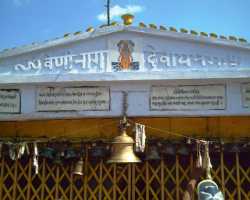Berinag
| Author:Laxman Burdak, IFS (R) |

- For city of same name in Jammu and Kashmir see Verinag
Berinag (बेरीनाग) is a village and tahsil in Pithoragarh district of Uttarakhand, India.
Variants
Location
Berinag is well connected by road with Almora-96 km, Nainital-160 km, Haldwani-200 km, Bageshwar-62 km, Pithoragarh-85 km. Berinag is located near the bank of Ramganga River.
Origin
- Beninag (बेणीनाग) - A Nagavanshi Ruler who founded Berinag in Pithoragarh district of Uttarakhand.
Jat clans
History

Veni Nag Devta Temple is a famous naga temple located in Berinag which is located 12 kilometers from Chaukori. There are numerous naga temples in and around Berinag.
Berinag gets its name from the Beninag Temple[1] (called as ‘Bedinag’ locally), which is a Nāg Devta Temple situated at the top of Berinag Hill. Berinag is among the many temples devoted to Nāgas namely Dhaulinag (Dhavalnag), Kalinag (Kaliyanag), Feninag (Faninag), Bashukinag (Vasukinag), Pinglenag and Harinag. Berinag offers a panoramic view of the Greater Himalayas, from Garhwal Himalayas to the Nepal ranges, especially lofty peaks like Panchachuli and Nanda Devi. The region is famous for tea estates developed during the British rule. The Berinag tea grown here was a highly sought-after tea in London tea.
Berinag - The town of Naga Temples: Being garnered with nature’s ethereal beauty, the kaleidoscopic Berinag is nestled in the Pithoragarh district of Uttarakhand. With the word 'Nag' or snake in its name, Berinag is not as precarious as it sounds and is more of a visitor's delight. Berinag sits at an average elevation of 1,860 meters, about 6,100 feet above sea level and was once popular by the name of Berinag. This place is famous for its ancient snake temples which have been erected in the town itself. Some of the famous attractions located in the proximity of Berinag are Didihat, Patal Bhuvaneshwar and Chaukori. [2]
बेरीनाग
बेरीनाग, जिसे बेड़ीनाग या बेणीनाग भी कहा जाता है, भारत के उत्तराखण्ड राज्य के कुमाऊँ मण्डल के पिथौरागढ़ ज़िले में स्थित एक हिल स्टेशन है। यह इसी नाम की तहसील का मुख्यालय भी है। नाम की उतपत्ति
नाम की उतपत्ति: नगर के समीप ही बेणीनाग का ऐतिहासिक मन्दिर है, जो कुमाऊँ के प्रसिद्ध नाग मन्दिरों में एक है। इस मन्दिर की लोकप्रियता के कारण इसके समीपस्थ क्षेत्र को भी कालांतर में बेणीनाग कहा जाने लगा। समय बीतने के साथ-साथ यह नाम पहले बेणीनाग से बेड़ीनाग हुआ, और फिर ब्रिटिश काल मे बेड़ीनाग से बदलकर बेरीनाग हो गया।
इतिहास: बेरीनाग ऐतिहासिक तौर पर गंगोली क्षेत्र के अंतर्गत माना जाता है। यहाँ तेरहवीं शताब्दी से पहले कत्यूरी राजवंश का शासन था। तेरहवीं शताब्दी के बाद यहाँ मनकोटी राजाओं का शासन स्थापित हो गया, जिनकी राजधानी मनकोट में थी।[3] सोलहवीं शताब्दी में कुमाऊँ के राजा बालो कल्याण चन्द ने मनकोट पर आक्रमण कर गंगोली क्षेत्र पर अधिकार कर लिया।[4] इसके बाद यह क्षेत्र 1790 तक कुमाऊँ का हिस्सा रहा। 1790 में गोरखाओं ने कुमाऊँ पर आक्रमण कर कब्ज़ा कर लिया, और फिर 1815 के गोरखा युद्ध में गोरखाओं की पराजय के बाद यहाँ अंग्रेज़ों का कब्ज़ा हो गया।
अंग्रेजी शासन काल में यहाँ चाय के कई बागान स्थापित किये गए। लगभग दो सदियों तक, बेरीनाग और चौकोरी में कई हेक्टेयर क्षेत्र में चाय के बागान फैले हुए थे। 1864 में, ये बागान थॉमस मैकिंस और एडवियरस स्लेनेगर स्टेपॉर्ड के थे, जो ब्रिटेन में पंजीकृत एक कंपनी थी। 1869 में ये "कुमाऊँ-अवध प्लांटेशन कंपनी" के स्वामित्व में आये, और उसके बाद जेम्स जॉर्ज स्टीवेन्सन, ने एक पंजीकृत बिक्री पत्र द्वारा इन्हें खरीद लिया। 1919 में यह भूमि ठाकुर देव सिंह बिष्ट और चंचल सिंह बिष्ट ने खरीदी थी। 1964-65 में इस क्षेत्र में कुल 9,667 नाली (195.4 हेक्टेयर) क्षेत्र में चाय के बागान फैले हुए थे।
80-90 के दशकों में इन बागानों में चाय का उत्पादन समाप्त सा हो गया और फिर धीरे धीरे एक पूरे शहर ने यहां आकार ले लिया। बेरीनाग क्षेत्र राईआगर और उडियारी के माध्यम से आस-पास के अधिकतर हिस्सों से जुड़ा हुआ था, और इसी कारण 2004 में डीडीहाट तहसील के 298 गांवों को स्थानांतरित कर बेरीनाग तहसील का गठन कर दिया गया। 2014 में नगर के केंद्र से होकर जाने वाली सड़क राष्ट्रीय राजमार्ग घोषित हो गयी; राष्ट्रीय राजमार्ग 309ए नामक यह राजमार्ग बेरीनाग को अल्मोड़ा, बागेश्वर और गंगोलीहाट से जोड़ता है।
External links
References
- ↑ "Pithoragarh District Gazetteer" (PDF).
- ↑ https://www.euttaranchal.com/tourism/berinag.php
- ↑ Ramesh, S; Ramesh, Brinda; Bisht, Jogendra (2001). Kumaon : Jewel of the Himalayas. New Delhi: UBS Publishers' Distributors. p. 11. ISBN 9788174763273.
- ↑ Handa, Umachand (2002). History of Uttaranchal. New Delhi: Indus Pub. Company. p. 71. ISBN 9788173871344.

